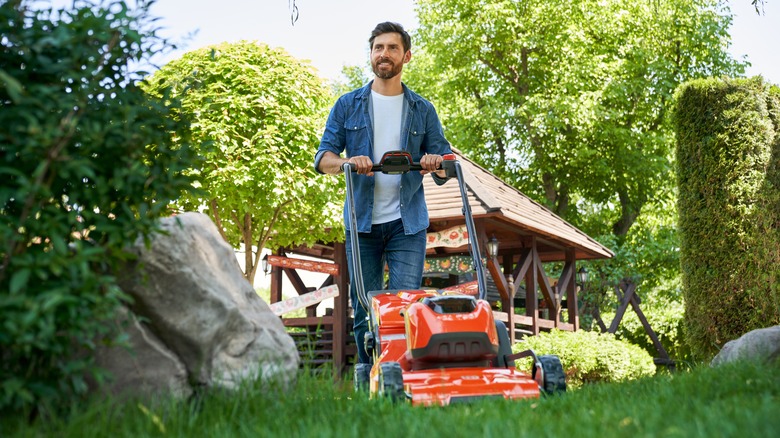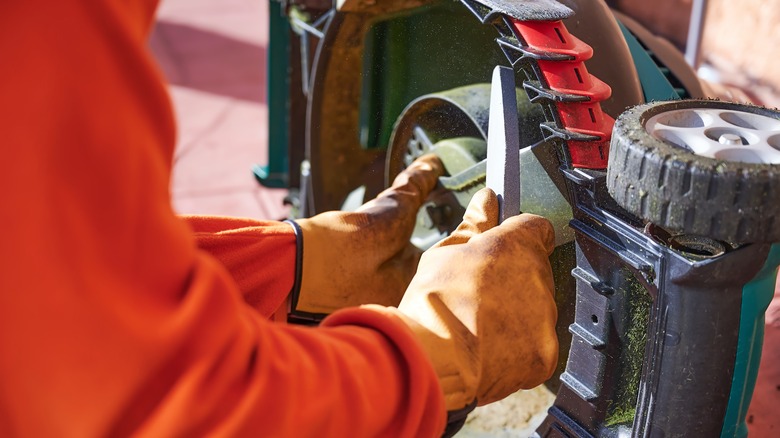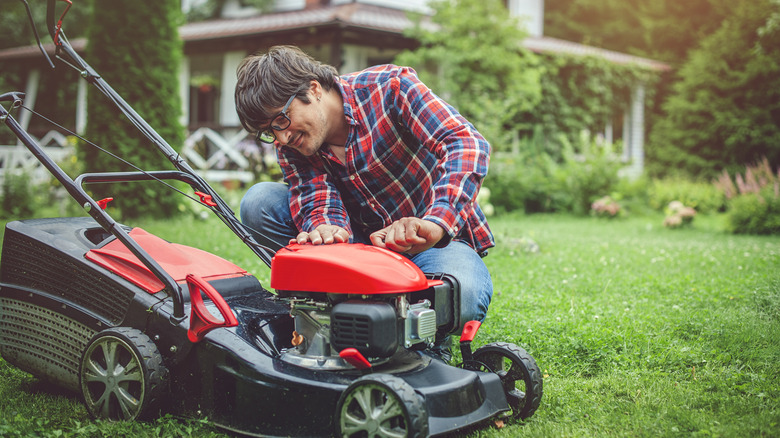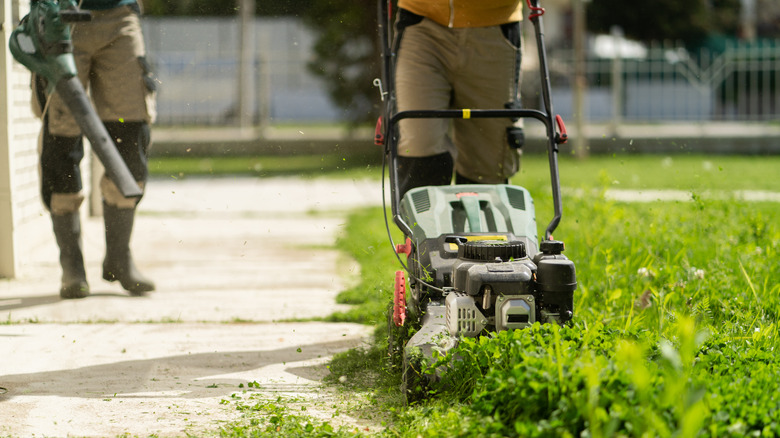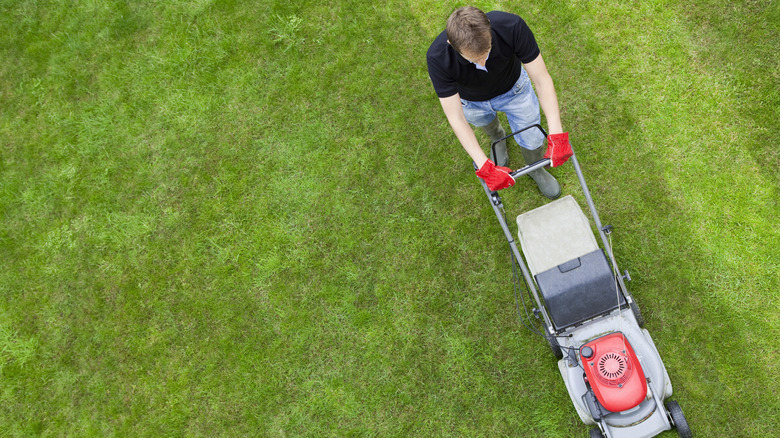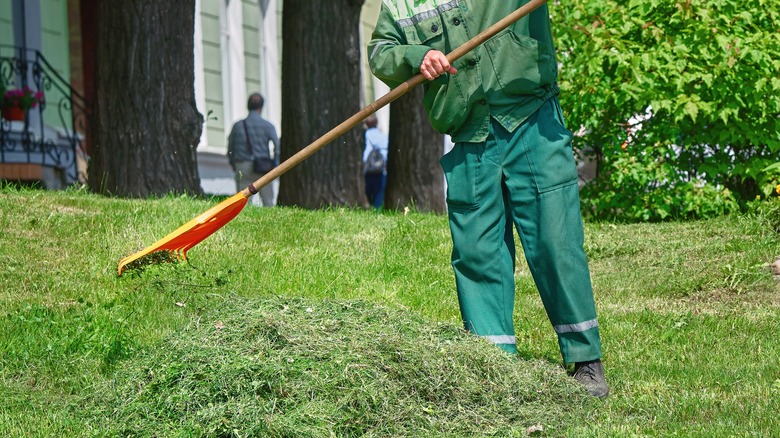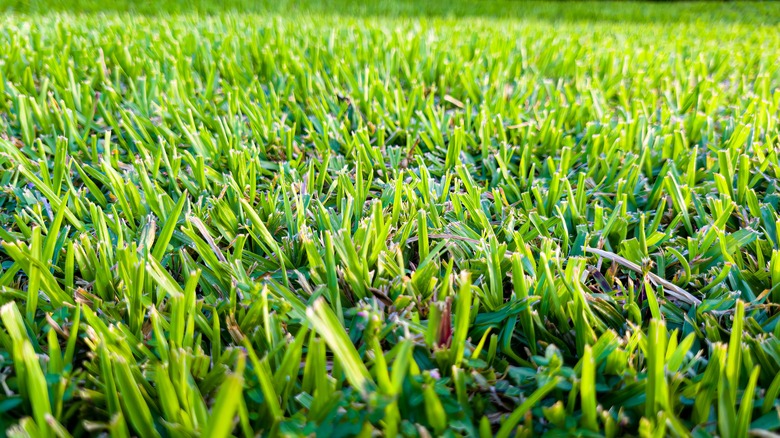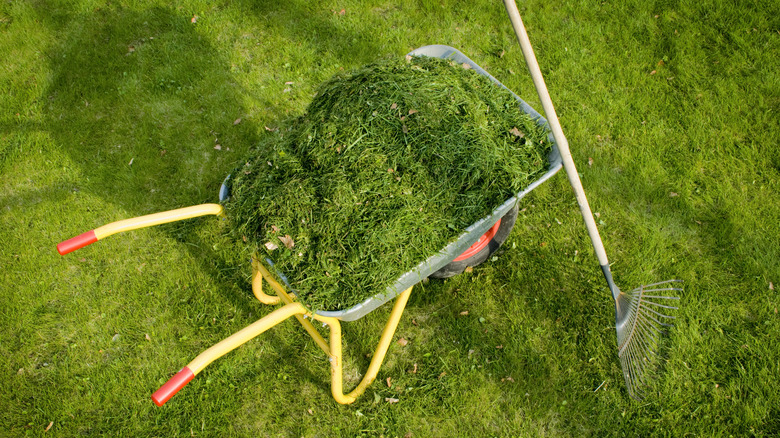The Best Methods For Mowing Your Lawn More Efficiently
Mowing your lawn is as easy as operating a lawn mower, right? But, not even a fancy riding mower can make the task go by any quicker if you're unorganized. If you run out of gas or can't decide where to put your lawn clippings, even a small yard can take the better part of your day. But, there are some tips that can help you mow more efficiently.
To mow your lawn "efficiently" means cutting out as much waste as possible. While we probably think of a waste of resources first, time and energy are just as important. By not thinking ahead, we end up retracing our steps, running last minute to the gas station, and attacking our lawn with the speed and force of a charging bull. So, if you aren't thinking about replacing your lawn anytime soon, these tips will help save you time and energy with a little bit of planning ahead.
Keep mower blades sharp
Would you shave with the same razor for years? While that's a solid no, many of us forget to show similar care for our mowers. If you don't sharpen the blades on your lawn mower, your grass will pay the price. Dull blades rip the grass, causing jagged edges that turn brown. Over time, these tears can lead to an increase in disease as your grass gets weaker. To avoid the long-term consequences, make some time at least once a year to sharpen the blades on your lawn mower.
The ease of this task will depend on what kind of mower you have. For a common push mower, the blades are on the bottom. However, we also want to mention safety at this point. You need to be very sure that the mower will not start while you are working underneath. Read the user manual for specific instructions on how to safely disable the machine and access the blades. Then you can use one of a few different methods to sharpen them. Using a metal file, a drill attachment, or a bench grinder will do the trick.
Start the project with everything you will need
Let's be honest. Most of us don't operate with premium efficiency in our daily lives. While at work we may have every task streamlined to maximize time and effort, the house chores often end up being a little more free-form. But, if you're trying to win back precious minutes stolen by the yard, take some time to gather yourself first. Run through a mental checklist of all of the things you need to have on hand to complete the task with minimal to no interruption. Does the lawn mower have a full tank of gas? Do you have some extra string for your weed whacker to carry with you? Even questions about you, the physical mower of the lawn, can save you time in the end. Did you fill up your water bottle? Did you bring out a bottle of sunscreen and a hat? Are you wearing the right kind of shoes?
While it seems tedious to think about all of this, you don't want to make these mistakes when you're mowing. When you least expect them, disasters will happen, and you could end up going back and forth to the house more times than necessary. So, be proactive and have solutions ready before disasters even happen.
Work in the right order
The method to the madness of mowing is to minimize backtracking. By following the order of trimming, then mowing, and then cleaning up with a blower afterward, you allow each step to work together. Start by trimming the edges of your yard with a weed whacker so that you don't have to maneuver the clunky lawnmower against obstacles. Trimming will throw clippings and debris, so the goal is to get it back out onto the yard that will be mowed next. The clippings can then be mulched and bagged by the next step: mowing.
By following this order, you maintain a predictable routine and avoid wasting time. If you mow first and then trim, all of the debris lands on top of the freshly cut grass. We will talk about whether you should leave the trimmings on the lawn later in this article, but many homeowners would opt to rake them up. Raking is an extra step that can be cut out of the equation. Besides, who likes overworking on their lawn?
Trim in one direction
We mentioned the importance of planning, but now we want to highlight habits and knowledge. Landscaping crews have mowing lawns down to a science, and one thing they don't waste time on is figuring out where to start. When you begin trimming the edges of your property, you should work counter-clockwise. The way most weed whackers, also known as string trimmers, rotate is counter-clockwise, so they throw clippings generally to the left. If you're moving counter-clockwise too, those clippings are going into the lawn that you are going to mow next. Otherwise, they will be on your fence, your house, or your sidewalk.
The reason you want to move in one direction is to avoid the waste of time caused by walking across your lawn to hit different spots. If it helps, picture your yard from above like you're looking at a picture from a drone. Pick one spot to start. Then you can visualize how starting at that spot and moving along the perimeter in one direction will hit every edge until you are back at your starting point. You save time by not wandering around and circling back to missed patches.
Pick your mowing pattern: stripes or circles
Just like picking one direction saves you time from indecision, picking a pattern and sticking to it is the most efficient way to hit every piece of grass. There are generally two useful patterns: stripes and circles. You can mow in straight lines, pivoting sharply at the edges of the yard, to get nice diagonal stripes, or you can mow around the edges, moving gradually inward in a circle. Either way, if you move consistently through the yard, you eliminate any need to backtrack for missed patches.
While you want to stick with whichever pattern you began with each session, you may also want to switch patterns between sessions. So, if you mow in diagonal stripes once, the next time you mow, you should do horizontal stripes or a circular pattern. Moving in the same pattern each time can cause your grass to lean in one direction or create ruts in your lawn! You can try keeping track on a whiteboard or piece of paper in your garage for even less brain power wasted.
Mow while the grass is dry
There are a lot of compelling reasons not to mow a wet lawn, and it is not just because wearing soggy pants and shoes is the worst. Wet grass doesn't cut as evenly as it does after drying off. You can also help keep your lawn healthy by mowing it only when it's dry: torn grass tends to weaken over time and is more prone to disease. A more immediate concern though is the way wet blades tend to clump together. Not only can they clog your mower, but the clumps can cause damage to your freshly cut lawn. The ball of discarded plant material will eventually smother the grass under it if you don't take the time and energy to rake it up and dispose of it afterward. So, whether you're stopping to pull junk out of your mower or adding an extra step at the end, it isn't very efficient to mow a wet lawn.To avoid this efficiency trap, plan your mowing around the weather, not your own whims. Professionals in the industry suggest mowing in the early evening because the hottest part of the day is over, good for you and the grass, and because the morning dew has dried off.
Build a healthier root system by only cutting ⅓ at a time
It's really tempting to buzz your lawn as short as possible on mow days. While short grass does take a little longer to grow back, the fewer mowing days for you aren't actually a victory. Cutting the blades too short consistently forces the plants to put more energy into growing up top and not below. A healthy root system is important for any plant, and your lawn is no different. Longer roots can reach deeper into the soil for water and nutrients, which equates to less time and money spent on fertilizer and water for you. So, aim to only cut 1/3 of the growth at a time. You can set your lawn mower to a higher setting to avoid cutting too much. Sure, this means your lawn is a little longer and that you will have to mow more often, but your grass will be so much healthier.
Consider leaving the clippings on the lawn
Lawn care practices are steeped in science, myths, and misconceptions passed down by word of mouth. Leaving the clippings on the freshly cut lawn is seen as unfinished to some sticklers for tradition, but still others promote the misconception that these clippings will lead to the development of thatch. Thatch is a very natural part of turf grass despite the drawbacks. This layer of dead plant material between the soil and the living blades can be perfectly natural and healthy if it doesn't get too thick. When thatch gets out of hand, it can hold water and nutrients above the soil, causing the grass to not root well.
However, your dry clippings do not cause a buildup in thatch. As they begin to break down, they encourage beneficial decomposers like worms to come up and eat the clippings. If you're only mowing 1/3 of the blades when the lawn is dry, leaving your clippings behind is helpful. Plus, it saves you so much time and energy since you don't have to rake and collect them.
